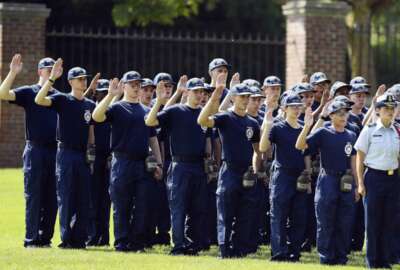
Navy looks to eliminate implicit bias in its ranks
Naval leadership wants to find bias or systemic racism in the ranks of the Navy and root it out.
Best listening experience is on Chrome, Firefox or Safari. Subscribe to Federal Drive’s daily audio interviews on Apple Podcasts or PodcastOne.
If there’s implicit bias or systemic racism in the ranks of the Navy, Naval leadership wants to find out and root it out. That’s the job of Task Force One. Two of the task force members joined Federal Drive with Tom Temin. First, the leader, director of Task Force One, Navy Rear Adm. Alvin Holsey, and supporting the task force is the Navy’s Force Master Chief Huben Phillips.
Interview transcript:
Tom Temin: Admiral Halsey, good to have you on.
Rear Adm. Alvin Holsey: Good morning. Glad to be here with you.
Tom Temin: And supporting the task force is the Navy’s force Master Chief Huben Phillips. Mr. Phillips, good to have on.
Master Chief Huben Phillips: Good morning. Glad to be here. Thank you.
Tom Temin: Let’s begin at the beginning here. What is the task force specifically designed to do?
Rear Adm. Alvin Holsey: Great question. The Navy decided based off the catalyst of all the things happening, recent events, the national unrest, if you will, following the death of Mr. George Floyd, to look at the Navy in general. So our task is to analyze and evaluate issues in society and the military that distract from Navy readiness, specifically looking at racism, sexism, other things that’s going to detract from that Navy readiness and that’s the key. We have to be ready to go fight and take our teams foward.
Tom Temin: Force Master Chief Huben Phillips, is there evidence that readiness somehow been hampered by issues related to racism or that type of thing in the Navy?
Master Chief Huben Phillips: Absolutely. We feel as a task force, not just as a task force as a Navy, this is flat out a readiness issue. So if we have biases, whether known or unknown, if we have systematic processes in place that doesn’t level the playing field for every sailor, every day, then absolutely, we consider that to be a true readiness issue.
Tom Temin: Because in the release about the task force, it noted that although about 20% of the recruits in the Navy are people of color, men and women, only 8 or 9% of the officer corps. So that’s something that’s happening throughout a career. And is that one of the issues you’re going to be looking at specifically?
Rear Adm. Alvin Holsey: Yes, as we look at the data, we’re going to really take a look, and everything we do is based off evidence, informed decisions, looking at the data. So right now, we will be addressing the recruiting process. Where do we get our talent from? Are we looking at the right communities? Are we going to communities that we don’t normally go into? So I think it’s be very key to how we push this forward, get the right talent. We know that talent is out there all over this country. And so again, we have to be able to go in mine that talent and make sure that we’re hitting the right places.
Tom Temin: What are some of the data sources that you’ll be looking at that will give you a picture of what’s going on?
Rear Adm. Alvin Holsey: Well, I’ll tell you that the Navy has a huge database of all types of data from male, female, gender, race, etc, that we can go and look for and that data is readily available. But really looking at it, parsing through it and making sure we can have some type of understanding point of where we’re at. And so that’s how we get there. We go back to our Navy personnel command, the Navy recruiting command and look at folks who have come in the last several years, multiple years, and see kind of work and we move the needle, where can we put extra emphasis in getting the right folks
Tom Temin: Besides the data analysis and looking at numbers, will you be also having listening sessions and trying to get some kind of anecdotal picture from the enlisted and officer corps.
Rear Adm. Alvin Holsey: So I will tell you that I’ve been saying this for my team and saying it for years now that every sailor has a story — and their unique story is what brought them to our Navy. Every story makes us stronger. Every story makes us richer. So myself and force, we’ve been going around the fleet, and along with our civilian counterpart, Mrs. Jane Roberts, and listening to sailors, and they have some very compelling stories. And those stories, really you have folks side by side, listen to each other, as amazing as a man and woman, two people sit by at work for 10 years, or five years, and don’t know the story and how things impact them personally. So we’re getting to know each other better as well. And we’re taking some of that feedback from the sailors and civilians and then putting it into our force, and so we can find out.
Tom Temin: And of course, you’ve both spent a lot of time on ships. I mean, Admiral Holsey commanded a carrier group, and Force Master Chief Phillips, I’m sure you’ve been on a ship or two in your career. When you mentioned that readiness can be affected, can you think of a time when maybe racial tension or someone’s dissatisfaction on that score affected an operation or made it more difficult to complete a task than it should have been otherwise?
Master Chief Huben Phillips: I don’t know if I could say at wide scale in terms of did it affect a mission, but I would tell you that if you look at an individual contact by the individual sailor, each sailor is tasked to do a job that contributes to that mission. So if he or she is being sought out, or feeling underrepresented, or not having the same opportunities, then absolutely, by and large, I believe one sailor at a time affects our overall mission.
Tom Temin: And Admiral Holsey.
Rear Adm. Alvin Holsey: Yes, so if you go back to the early 70s, late 60s, we saw kind of massive kind of conflict on ships during that time. We don’t see that today, but Force is spot on from the standpoint of any issue that a person’s not focused on, or they feel that they don’t belong, it causes problems. And I will tell you that I believe that we have more in common than we have differences. And the more we talk to each other, again, that talks and builds teamwork, teamwork builds trust. So we have people trusting each other, and side by side on ship it doesn’t matter where you’re at, you can function better. And so but we have those distractions, you have those uprisings, those bad thoughts, if you will, and people can’t fit in, it becomes a problem.
Tom Temin: Sure. And let me ask you this, as you look at the promotion and the people that are moved up through the ranks and try to make it more representative of what the recruit base looks like and what the regular sailor base looks like, you need to also maintain thorough meritocracy too. So what is the challenge and balancing all of that?
Rear Adm. Alvin Holsey: Well, they give a look at a couple things. We had a great brief a couple weeks ago about a true meritocracy, are we a true meritocracy. There are a lot of things that comes into place to get a person to where they are. So if you think about a person saying, hey I’m successful because I worked hard, or if you’re unsuccessful, it’s because you’re lazy. Is that a true case? And oh by the way, there are other things that comes into play in a person’s career, whether they have great advocacy, better schooling, and other things can help a person to propel some and pull others back. So I think everyone at this level works hard. Well, I’d like to think that. But at some point, there are other things that can come into play, and we make sure we look at those very clearly and identify them.
Tom Temin: And what are the timelines and deliverables for the taskforce?
Rear Adm. Alvin Holsey: So right now, we just stood up roughly 30 days in right now. And so we’re looking at having a final report published out to the CNO about end of December. And then we have some updates over the course of the next three months as we go and kind of dig into this and give the CNO some monthly updates as well.
Tom Temin: Before we let you go, I wanted to ask this. I’ve spoken to a lot of high level senior executive civilian service members of color, and also a number of military officers of high rank of color in a series of interviews we’ve been doing. And just briefly, what Admiral Holsey, we’ll start with you, is your experience coming up through the ranks, personally, as a black Rear Admiral?
Rear Adm. Alvin Holsey: I’d say early on, I joined the Navy because I wanted to fly, and I stayed because I wanted to lead and make a difference. I’ll tell you early in my career, I was always a one of and even as I come through ranks, still kind of a one of in a lot of situations. It can be disheartening at times. You can feel uncomfortable at times, but I think you know what you’ve done and how well you can fly aircraft or drive a ship, you go out and execute. And I will say this, so early on, there were times when I didn’t necessarily trust people, but I realize that sometimes you have to trust somebody and they don’t actually have to look like you. Have had mentors who are both black and white, who engaged and showed me a path forward. Again, I think part of it is understanding that you belong. And a lot of times people won’t necessarily reach out and extend a hand to you and say, hey yeah you’re like us, you can fly with us. But you go and prove yourself again and again, and sometimes you have obstacles in the way. You take those on board, you see if you can learn from it, and you push forward.
Tom Temin: And did it occurred to you when you were the Carrier Strike Force One Commander that the flagship, the Vinson, was named for a congressman who was a great champion of the Navy, but also a committed segregationist.
Rear Adm. Alvin Holsey: Yeah, you make a very good point. I’m a from a small town in Georgia. And when I look at that piece there, I like to think that times have changed. And quite frankly, I’d like to think that if Congressman Vinson was alive today and saw me in command of a Carrier Strike Group in honor of his name, he would realize the progress that our nation has made, and realize that times have changde and we all can contribute to this country. So that’s how I like to think about it.
Tom Temin: And Force Master Chief Phillips, a little bit about your experience.
Master Chief Huben Phillips: Yeah. I will tell you it’s kind of amazing because Admiral Holsey and I, we’re both from the south, but our experiences in the Navy although different in terms of officer and enlisted, experiences were the same. And I know for me personally growing up in the south, I came into the Navy with my perceptions of people and it was based off how I was raised and and experiences that I had. And I would tell you joining the Navy as a hospital corpsman, an FMF corpsman specifically, something happens when you go into combat with men who don’t look like you are after the same objective, and the willingness to survive and the willingness to fight kind of puts all that stuff on the back shelf. So that level of connection really opened my eyes to say hey maybe everything is not as good as I thought it was in totality. But I’ve been there and even at this level. There are many times I am the only one in the room that looks like me, and I’m mindful of that. And so within that space, I’m measured in my approach and I’m very calculated as to my interactions and how I deal in that space. So nevertheless, I had that level of advocacy from not just people who look like me, but people who didn’t who offered me opportunity, who provided me that mentorship that I would have most likely not received. So I’m very proud of that and very thankful for that. Hence my drive to really get back to this and to be all in Task Force One Navy and having the impact for generations down the road to benefit from that work that we’ve done here.
Tom Temin: Navy Force Master Chief Huben Phillips, thanks for joining me.
Master Chief Huben Phillips: My pleasure sir. Thanks for having me.
Tom Temin: And Rear Admiral Alvin Holsey. Thank you, sir.
Rear Adm. Alvin Holsey: Thanks Thomas, great time.
Copyright © 2024 Federal News Network. All rights reserved. This website is not intended for users located within the European Economic Area.
Tom Temin is host of the Federal Drive and has been providing insight on federal technology and management issues for more than 30 years.
Follow @tteminWFED
Related Stories





